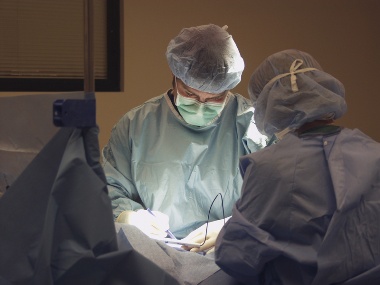Laparoscopy (keyhole surgery)
Overview


Laparoscopy is a type of surgical procedure that allows a surgeon to access the inside of the abdomen (tummy) and pelvis without having to make large incisions in the skin.
Why a laparoscopy is done
A laparoscopy can be used to diagnose conditions such as appendicitis, pelvic inflammatory disease, endometriosis and some cancers, such as liver cancer and ovarian cancer.
It's also used for surgery to treat conditions, such as:
- removing organs such as the appendix or gallbladder
- repairing hernias or burst or bleeding stomach ulcers
- removing organs affected by cancer, such as the ovaries, prostate or liver
- treating an ectopic pregnancy
- removing the womb (hysterectomy) or fibroids
- weight loss surgery
A laparoscopy is often recommended because the recovery time is faster than other types of surgery.
Preparing for a laparoscopy
The hospital will give you information about how to prepare for a laparoscopy.
Depending on why you're having a laparoscopy, you may be asked to do certain things, such as:
- not eating or drinking
- stop taking certain medicines, such as anticoagulants
- stop smoking
You cannot drive after having a laparoscopy, so you'll need to organise for someone to drive you home.
What happens during a laparoscopy
If you're having a laparoscopy to diagnose a condition, it usually takes between 30 and 60 minutes. It'll be longer if you're having surgery to treat a condition.
A laparoscopy is done under general anaesthetic, so you'll be asleep during the operation and will not feel any pain.
- The surgeon will make a small cut, usually near your belly button.
- Air is pumped into your tummy through the cut so the surgeon can see inside your tummy more easily.
- A thin, flexible tube with a camera inside (a laparoscope) is then put into the cut so video images of the inside of your tummy can be shown on a screen.
- If you're having surgery, more small cuts may need to be made in your tummy for the surgeon to pass their tools through.
- When it's finished, the air is let out of your tummy and the cuts are closed with stitches or clips, and a dressing is placed on top.
After the operation
You'll spend some time in the recovery room and have medicine to help with pain and swelling.
After the operation, you may:
- feel sick or be sick
- feel more tired than normal
- have a sore throat
- have bloating, cramps or pain and discomfort in your tummy
- get shoulder pain
- have bruises around your wounds
Most people can leave hospital either on the same day or the day after.
Recovering from a laparoscopy
How long it takes to recover from a laparoscopy varies.
It usually takes up to 5 days if you had it to diagnose a condition, or up to 6 to 8 weeks to fully recover if you've had surgery.
There are things you can do to help your recovery.
Do
- take paracetamol or ibuprofen to help with any pain
- make sure you drink lots of fluids and have a healthy diet
- wear compression stockings if you've been given some
- move around as much as you can
- do foot and leg exercises, such as moving your ankles in circles, while you're resting
- keep your wound dry for the first 24 hours – you can shower after this, but make sure the water is not too hot, as it can make the wounds bleed
Don't
- do not have a bath for the first 2 weeks, or until the wound has healed
- do not drive for 48 hours or until you can do an emergency stop (but check with your insurer first)
- do not fly for 48 hours after having a laparoscopy
- do not drink alcohol for 48 hours
- do not smoke as it can take your body longer to heal
Possible complications of a laparoscopy
A laparoscopy is a common procedure.
Complications are rare, but can include:
- needing to have open surgery with a larger cut
- a hernia
- damage to an organ, such as your bladder
- damage to a blood vessel
- a serious allergic reaction (anaphylaxis) to the general anaesthetic
- blood clots, such as a DVT (deep vein thrombosis) or pulmonary embolism
Ask for an urgent GP appointment or get help from NHS 111 if:
You recently had a laparoscopy and:
- you have a high temperature or are getting chills
- you have severe or continuous vomiting
- your tummy pain is getting worse
- your tummy is bloated
- there's pain, swelling, bleeding or pus or redness around your wounds – the redness may be more difficult to see on brown or black skin
- you have any unusual bleeding or discharge from your vagina, penis or bottom
- you have pain and swelling in 1 of your legs
- you're coughing up blood
- you have difficulty breathing – you may be more short of breath than usual
You can call 111.
Call 999 or go to A & E if:
You recently had a laparoscopy and:
- you have a very fast heartbeat
- you have pain in your chest
- you have severe difficulty breathing – you're gasping, choking or not able to get words out
Find your nearest A & E
The information on this page has been adapted by NHS Wales from original content supplied by  NHS website nhs.uk
NHS website nhs.uk
Last Updated:
21/05/2024 13:31:32